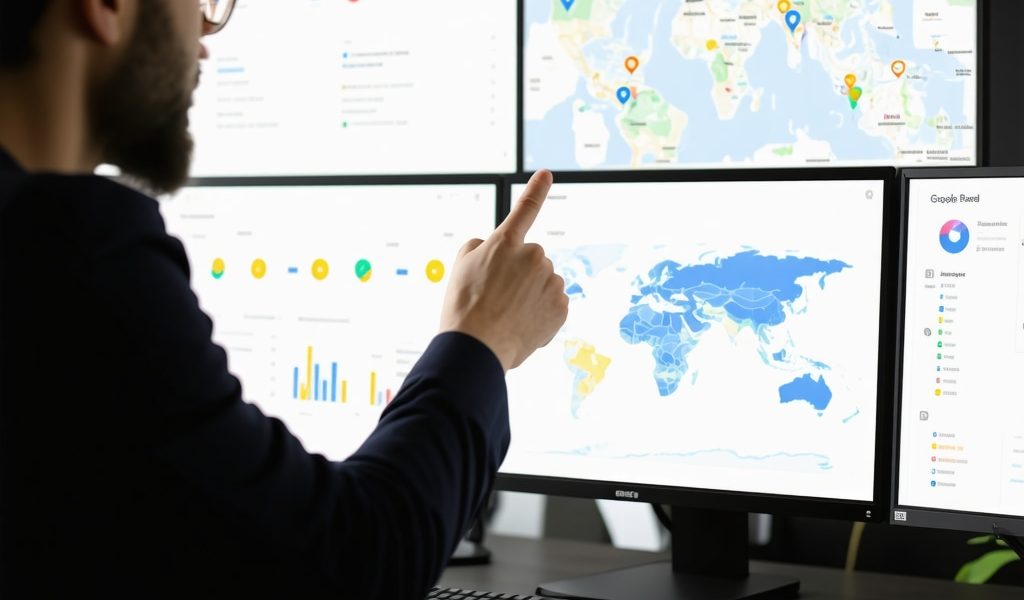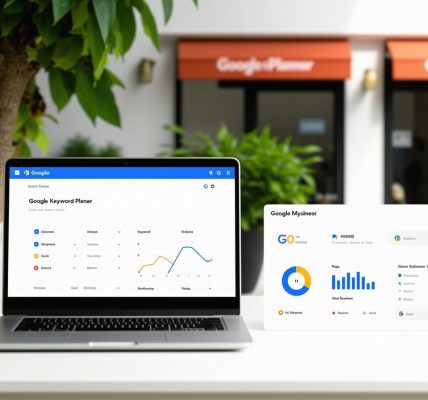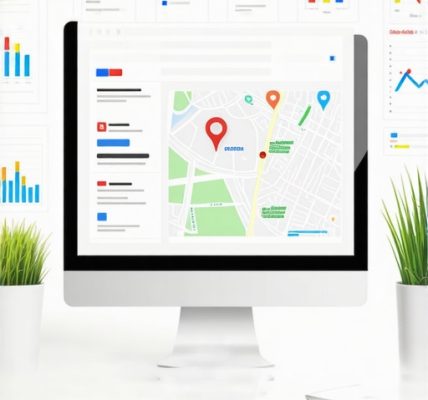Unlocking the Secrets of Google Maps Domination
In today’s fiercely competitive local market, securing a prime spot on Google Maps can be the difference between thriving and merely surviving. Google My Business (GMB) ranking techniques have evolved beyond simple listing optimization; mastering them requires a blend of strategic insight and hands-on application. This article dives deep into proven methods that elevate your presence, leveraging Google’s algorithms to ensure your business shines in local search results.
Crafting a Magnetic and Complete GMB Profile
A compelling Google Business Profile is much more than just a digital business card. It’s a dynamic platform where every detail counts—from accurate NAP (Name, Address, Phone Number) consistency to engaging business descriptions infused with local keywords. Filling out every relevant field and regularly updating photos and posts signals to Google that your profile is active and trustworthy. For instance, businesses that maintain updated service menus and respond promptly to reviews often experience a notable boost in map rankings.
Harnessing the Power of Local Citations and Consistency
One of the pillars of local SEO success is consistent citation management across authoritative directories and platforms. Citations act as endorsements that reinforce your business’s legitimacy and location relevance. However, mismatched or outdated information can dilute your rankings. Implementing expert GMB citation management strategies ensures that your business data remains uniform, enhancing your local search authority. According to Moz, citation consistency is a critical factor in Google’s local ranking algorithm (Moz Local SEO Guide).
Engaging Customers Through Reviews: The Trust Catalyst
Reviews do more than just build reputation—they actively influence your GMB ranking. Encouraging genuine, detailed customer feedback enhances your profile’s credibility and increases engagement signals that Google values highly. Strategically responding to reviews, both positive and negative, demonstrates responsiveness and care, further elevating your standing. Exploring best practices for review generation and management will help you harness this powerful ranking lever effectively.
How Can Advanced GMB Posts and Keyword Optimization Propel Your Rankings?
Google Business Posts are an underutilized asset for boosting local SEO. Regularly publishing posts with targeted keywords aligned to your services and local intent can significantly improve your visibility in Google Maps. Keyword research tailored to local queries, such as “near me” searches, ensures your content resonates with potential customers. For detailed guidance, explore strategies on dominating local SEO through optimized Google Business posts. This approach not only enriches your profile but also keeps your audience informed and engaged.
Tracking Performance and Iterative Improvement
Continuous monitoring of your GMB insights is essential to understand which strategies yield the best results. Leveraging Google’s analytics tools allows you to track user actions, queries, and engagement patterns. This data-driven approach facilitates informed adjustments, helping you refine keywords, update business information, and tailor customer interactions. Effective performance tracking is discussed comprehensively at how to track GMB performance and improve local search results.
Embracing these proven GMB ranking techniques requires dedication but offers rewarding visibility gains. By maintaining an authoritative, consistent, and engaging profile, you unlock the pathway to top Google Maps positions, driving more local traffic and business growth.
Ready to elevate your local presence? Share your experiences or questions below to join the conversation and learn from fellow local SEO experts.
Beyond Basics: The Subtle Art of User Engagement on Your GMB Profile
From my experience, one of the game-changing strategies to improve Google Maps ranking is enhancing user engagement beyond the usual updates. I learned that creating interactive posts, such as polls or questions, not only invites users to participate but also boosts the profile’s activity signals. When I added this element to a client’s Google Business Profile, we saw a noticeable jump in engagement metrics over just a few weeks. It’s a reminder that Google values profiles that feel alive and connected to their audience.
Leveraging Google Q&A for Customer Interaction and SEO
Another often overlooked feature is the Google Q&A section. Initially, I underestimated its SEO potential, thinking it was just a casual FAQ. However, by proactively answering common questions and encouraging customers to ask, I’ve found it significantly enriches the profile with relevant keywords and enhances user trust. This tactic aligns well with findings from Search Engine Journal, which highlights that active Q&A sections contribute positively to local SEO. (Source)
Curious How Consistent Updates Influence Your Local Ranking Over Time?
It’s natural to wonder whether all these continual updates—posts, photos, reviews, Q&A—really make a long-term impact or if it’s just short-lived. From my journey, consistency is the secret sauce. Regular updates keep your business relevant in Google’s eyes and provide fresh content for users, which in turn fosters higher ranking stability. If you’re unsure where to start, prioritizing weekly posts and monthly review responses can set you on the right path.
Integrating Offline and Online Strategies for Maximum Impact
One insight that transformed my approach was realizing the power of bridging offline marketing efforts with online GMB optimization. For example, promoting your Google Business Profile in your physical store with signage encouraging reviews or Q&A participation helps generate authentic user engagement. This holistic approach not only drives more customer interaction but also signals to Google that your business is active and trusted in the real world.
If you want to explore deeper tactics on how to elevate your Google My Business ranking, I highly recommend checking out expert guides that walk you through advanced techniques and case studies.
What’s your experience been with Google Business Profile updates and engagement? Do you find certain strategies work better in your niche? Feel free to share your stories and questions below — I love hearing how different tactics play out in the real world!
Decoding Behavioral Signals: How User Interaction Shapes Your Local Ranking
Google’s algorithm increasingly prioritizes behavioral signals derived from how users interact with your Google Business Profile. Beyond traditional SEO elements, engagement metrics like click-through rates on your listing, direction requests, and call actions serve as proxies for relevance and user satisfaction. These real-time interactions inform Google’s machine learning models, refining local search results dynamically. Businesses that optimize their GMB profiles to encourage specific actions—such as booking appointments directly or requesting quotes—can significantly influence these behavioral signals.
Moreover, the integration of Google Analytics with GMB insights allows for granular tracking of user pathways, enabling local marketers to identify which touchpoints convert best. This data-driven approach is crucial for calibrating your listing’s call-to-actions and content to align perfectly with user intent.
Semantic Search and Latent Intent: Enriching Your Profile for Next-Gen Local SEO
Semantic search optimization is the frontier of local SEO evolution. Google no longer relies solely on keywords but interprets the underlying intent behind queries. Integrating semantically related terms and contextually rich content into your GMB description, posts, and Q&A enhances your profile’s relevance for a broader range of search variations. For instance, if you operate a boutique bakery, incorporating terms like “artisan bread,” “gluten-free options,” and “local ingredients” within your profile creates a semantic web that captures nuanced search intents.
Employing structured data markup, even beyond GMB’s native capabilities, on your website can further reinforce this semantic network, signaling to Google the depth and breadth of your offerings. This holistic optimization strategy aligns with insights from the Google Structured Data Guidelines for Local Businesses, which emphasize the importance of comprehensive data for enhanced local search visibility.
What Role Does Behavioral Data Play in the Evolution of Google Maps Ranking Algorithms?
Behavioral data increasingly influences Google Maps rankings by demonstrating actual user preference and satisfaction. Google evaluates how often users click on your listing, request directions, call your business, or interact with posts. These actions are weighted alongside traditional SEO factors to prioritize listings that provide tangible user value. The shift towards behavior-driven ranking underscores the importance of optimizing both the content and user experience of your GMB profile to encourage meaningful interactions.
Research from Search Engine Land confirms that behavioral signals have become a key ranking component, emphasizing that businesses must focus on engaging user experiences to maintain competitive advantage.
Integrating these advanced ranking signals requires a nuanced understanding of your local audience and continuous refinement of your digital touchpoints. Experiment with varied post formats, call-to-action placements, and personalized responses to optimize behavioral engagement.
Ready to push your Google Business Profile beyond basic optimization? Dive into the latest behavioral analytics and semantic strategies to future-proof your local SEO efforts. Join our expert webinar or subscribe to our deep-dive newsletters to stay ahead in the competitive Google Maps landscape.
Decoding the Impact of Behavioral Engagement Metrics on Google Maps Rankings
Modern local SEO transcends traditional keyword tactics, increasingly relying on nuanced behavioral engagement metrics. Google’s sophisticated algorithms assess how users interact with your Google Business Profile—click-through rates, direction requests, phone calls, and booking actions—to gauge relevance and satisfaction. These behavioral signals serve as pivotal ranking determinants, encouraging businesses to optimize not only their content but also user experience elements that foster meaningful interactions.
Integrating Google Analytics with GMB insights facilitates granular analysis of user pathways, enabling marketers to identify and amplify the most effective touchpoints. This data-driven calibration of calls-to-action and content ensures alignment with local searcher intent, ultimately boosting conversion and ranking simultaneously.
Harnessing Semantic Search and Latent Intent for Cutting-Edge Local SEO
As Google’s understanding evolves, semantic search and latent intent have emerged at the forefront of local SEO innovation. Optimization now requires embedding contextually rich, semantically related terms throughout your profile and posts, thereby capturing a broad spectrum of nuanced queries. For example, a boutique bakery incorporating phrases such as “artisan sourdough,” “organic ingredients,” and “custom cake orders” creates a semantic network that resonates deeply with diverse search intents.
Beyond GMB, implementing structured data markup on your website reinforces this semantic framework, enhancing Google’s comprehension of your offerings and improving local search visibility. The Google Structured Data Guidelines for Local Businesses provide authoritative insights on this advanced tactic.
How Can Behavioral Data Analytics Be Leveraged to Refine Google Maps Ranking Strategies?
Behavioral analytics offers a transformative lens through which local SEO professionals can refine their ranking strategies. By systematically tracking user engagement patterns—such as frequency of map clicks, interaction with posts, and conversion actions—businesses gain actionable intelligence to tailor their profiles dynamically. This continuous refinement fosters enhanced user satisfaction signals, which Google’s algorithms reward with improved rankings.
Research by Search Engine Land underscores the growing prominence of these behavioral signals, highlighting their role in local pack visibility. Strategic experimentation with diverse post formats, interactive CTAs, and personalized review responses can maximize these engagement metrics.
Invitation to Action: Elevate Your Local SEO with Advanced Behavioral and Semantic Insights
Embracing these advanced methodologies positions your business at the vanguard of Google Maps ranking evolution. Dive deeper into behavioral data analytics and semantic optimization to unlock sustained local visibility and competitive advantage. Subscribe to our expert-led webinar series or join our exclusive newsletter for cutting-edge tactics and real-world case studies.
Engage with the community: share your experiences or pose challenging questions below and participate in elevating local SEO discourse to new heights.

Frequently Asked Questions (FAQ)
What is the most critical factor in improving Google Maps ranking?
The most critical factor is a combination of a fully optimized Google Business Profile with consistent, accurate citations and active user engagement signals such as reviews, clicks, and direction requests. Google values profiles that are not only complete but also demonstrate ongoing interaction and relevance to local searchers.
How do customer reviews influence Google My Business ranking?
Customer reviews impact ranking by increasing trust and credibility signals to Google. Detailed, genuine reviews improve profile authority while prompt, thoughtful responses to reviews boost engagement, signaling to Google that your business values customer interaction, which enhances local search visibility.
Can regular Google Business Posts really affect local search rankings?
Yes, regular posts with targeted local keywords and calls to action keep your profile fresh and relevant. They improve engagement metrics and help Google understand your current offerings and promotions, which positively influences your ranking in local search results.
Why is citation consistency important for local SEO?
Citation consistency ensures uniform business information across all directories and platforms. Mismatched or outdated data can confuse search engines and users alike, reducing your local authority and harming your Google Maps ranking. Maintaining consistent NAP information strengthens your business’s trustworthiness.
How do behavioral signals affect Google Maps rankings?
Behavioral signals such as clicks on your listing, requests for directions, calls, and bookings indicate user interest and satisfaction. Google’s algorithm increasingly uses these real-time interactions to rank businesses that provide valuable user experiences higher in local search results.
What role does semantic search play in optimizing a Google Business Profile?
Semantic search enables Google to interpret the intent behind queries. Incorporating contextually relevant and semantically related terms in your profile and posts broadens your visibility to varied search intents, making your listing more comprehensive and relevant to users’ nuanced searches.
How can I use Google Q&A to improve my business profile?
Proactively managing the Q&A section by answering common questions and encouraging customers to ask queries adds valuable, keyword-rich content to your profile. This builds trust, improves user interaction, and helps Google better understand your business offerings, which collectively enhance your local SEO.
Is integrating offline marketing with GMB optimization effective?
Yes, integrating offline efforts—like encouraging in-store customers to leave reviews or participate in Q&A—boosts authentic engagement and signals to Google that your business is active and trusted in the real world, which can positively impact your Google Maps ranking.
How often should I update my Google Business Profile?
Consistency is key. Aim to update your profile with new posts weekly, respond to reviews monthly, and refresh photos regularly. This continual activity signals to Google that your business is active and engaged, stabilizing and improving your local ranking over time.
Can Google Analytics be used to improve my Google Maps ranking?
Integrating Google Analytics with your Google Business Profile insights enables detailed tracking of user behavior and conversion paths. This data helps you identify which user interactions lead to business goals, allowing you to optimize your profile content and CTAs to enhance engagement and rankings.
Trusted External Sources
- Moz Local SEO Guide: Provides authoritative insights on citation management and local SEO best practices, essential for understanding how consistent business data impacts Google Maps rankings.
- Google Structured Data Guidelines for Local Businesses: Official Google documentation explaining how structured data markup enhances local business visibility and semantic search relevance.
- Search Engine Land: Industry-leading publication offering in-depth research and analysis on behavioral signals and their influence on Google Maps ranking algorithms.
- Search Engine Journal: Offers expert articles and case studies on leveraging Google My Business features like Q&A and review management for improved local SEO.
- Google My Business Help Center: Provides the latest updates, features, and official recommendations directly from Google on optimizing your business profile for local search.
Conclusion: Elevate Your Google Maps Ranking with Expert Strategies
Securing a top position on Google Maps requires a sophisticated blend of comprehensive profile optimization, consistent citation management, and dynamic user engagement strategies. By thoughtfully integrating behavioral signals, semantic search principles, and offline-online synergy, businesses can meaningfully enhance their local visibility and attract targeted customer traffic. The evolving landscape of Google’s algorithms rewards profiles that are not only complete but also actively responsive to user intent and interaction patterns.
Armed with this expert knowledge, take decisive action today: refine your Google Business Profile, foster authentic customer interactions, and employ data-driven insights to adapt and innovate. Share your results, engage with fellow local SEO professionals, and dive deeper into advanced tactics to stay ahead in the competitive Google Maps ecosystem.


